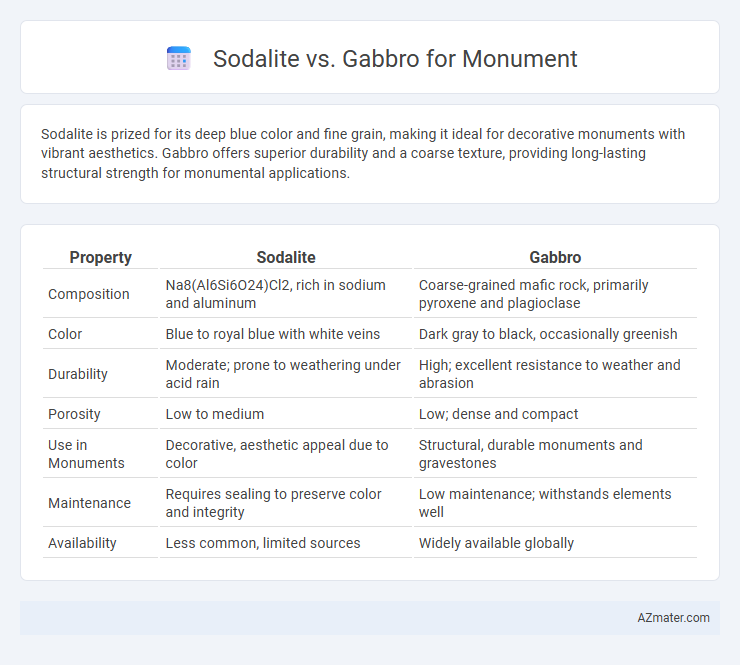Sodalite is prized for its deep blue color and fine grain, making it ideal for decorative monuments with vibrant aesthetics. Gabbro offers superior durability and a coarse texture, providing long-lasting structural strength for monumental applications.
Table of Comparison
| Property | Sodalite | Gabbro |
|---|---|---|
| Composition | Na8(Al6Si6O24)Cl2, rich in sodium and aluminum | Coarse-grained mafic rock, primarily pyroxene and plagioclase |
| Color | Blue to royal blue with white veins | Dark gray to black, occasionally greenish |
| Durability | Moderate; prone to weathering under acid rain | High; excellent resistance to weather and abrasion |
| Porosity | Low to medium | Low; dense and compact |
| Use in Monuments | Decorative, aesthetic appeal due to color | Structural, durable monuments and gravestones |
| Maintenance | Requires sealing to preserve color and integrity | Low maintenance; withstands elements well |
| Availability | Less common, limited sources | Widely available globally |
Introduction to Sodalite and Gabbro
Sodalite is a rich royal blue tectosilicate mineral often used in monuments for its striking color and smooth texture, known for enhancing visual appeal and symbolic significance. Gabbro, a coarse-grained mafic intrusive rock primarily composed of plagioclase feldspar and pyroxene, offers exceptional durability and strength, making it ideal for structural monument applications. Both materials bring unique aesthetic and physical properties that cater to different design requirements in monument construction.
Geological Origins and Composition
Sodalite is an igneous rock rich in sodium, aluminum, and chloride, forming in silica-poor environments within nepheline syenites, known for its vibrant blue color and translucence ideal for ornamental monuments. Gabbro, a coarse-grained mafic intrusive rock, derives from slow-cooling magma beneath the Earth's crust, primarily composed of calcium-rich plagioclase feldspar and pyroxene, providing durability and a dark, dense aesthetic suitable for monumental structures. The distinct mineral compositions and geological origins of sodalite and gabbro influence their physical properties and visual appeal, making sodalite prized for decorative use and gabbro favored for structural monument applications.
Physical Appearance and Color Variations
Sodalite displays a rich royal blue color often interspersed with white veins or patches, creating striking contrasts ideal for decorative monuments. Gabbro ranges from dark gray to black with a coarse-grained texture, offering a more uniform and subdued appearance suitable for traditional, durable memorials. Both stones exhibit durability, but sodalite's vibrant hues provide unique aesthetic appeal, while gabbro's color variability supports versatile design preferences in monument construction.
Strength and Durability Comparison
Sodalite, a deep blue feldspathoid mineral, offers moderate strength and good aesthetic appeal but is less durable compared to Gabbro, an intrusive igneous rock composed mainly of plagioclase and pyroxene. Gabbro possesses higher compressive strength, superior weather resistance, and exceptional durability, making it more suitable for outdoor monuments exposed to harsh environmental conditions. The dense, coarse-grained texture of Gabbro contributes to its ability to withstand physical wear and maintain structural integrity over long periods.
Weather Resistance and Outdoor Performance
Sodalite and gabbro both offer strong weather resistance, but gabbro outperforms sodalite in outdoor monument applications due to its higher durability and lower porosity, which reduces water absorption and weathering effects. Gabbro's coarse-grained texture and mineral composition provide excellent resistance to freeze-thaw cycles, making it ideal for harsh climates. Sodalite, while visually striking with its deep blue hues, is softer and more prone to surface erosion when exposed continuously to environmental elements.
Workability and Sculpting Ease
Sodalite offers moderate workability due to its relative softness and uniform texture, making it easier to carve detailed sculptures compared to Gabbro. Gabbro, being a coarse-grained, dense igneous rock, presents higher hardness and toughness, which requires specialized tools and techniques for sculpting but provides superior durability for outdoor monuments. The choice between Sodalite and Gabbro hinges on the desired balance between ease of sculpting and long-term structural resilience in monumental applications.
Cost and Availability
Sodalite and Gabbro differ significantly in cost and availability for monument use. Sodalite, being a semi-precious stone with striking blue hues, commands higher prices and is less widely sourced, making it more expensive and less accessible for large-scale monument projects. Gabbro, a common igneous rock, offers excellent durability at a lower cost due to its widespread availability, making it a more economical choice for monument construction.
Environmental Impact and Sustainability
Sodalite and Gabbro differ significantly in environmental impact and sustainability for monument use, with Gabbro often favored due to its abundant availability and lower extraction footprint. Mining Sodalite can lead to habitat disruption because of its relative rarity and higher demand for specialized quarrying methods. Gabbro's durability and resistance to weathering contribute to longer monument lifespan, reducing the need for frequent replacements and thereby supporting sustainable construction practices.
Common Monument Applications
Sodalite is favored in monuments for its vibrant blue hues and decorative appeal, often used in interior architectural elements and ornamental panels. Gabbro, a durable coarse-grained igneous rock, is commonly employed in outdoor monuments and gravestones due to its high resistance to weathering and mechanical strength. Both stones enhance monument aesthetics, but Gabbro's robustness makes it more suitable for long-lasting exterior applications.
Choosing Between Sodalite and Gabbro for Monuments
Sodalite offers vibrant deep blue hues with white veining, making it an ideal choice for monuments requiring distinctive color and aesthetic appeal. Gabbro is a dense, dark, coarse-grained igneous rock known for its durability and resistance to weathering, providing long-lasting structural integrity for outdoor monuments. Choosing between Sodalite and Gabbro depends on whether visual impact or longevity under harsh conditions is the primary priority for the monument project.

Infographic: Sodalite vs Gabbro for Monument
 azmater.com
azmater.com